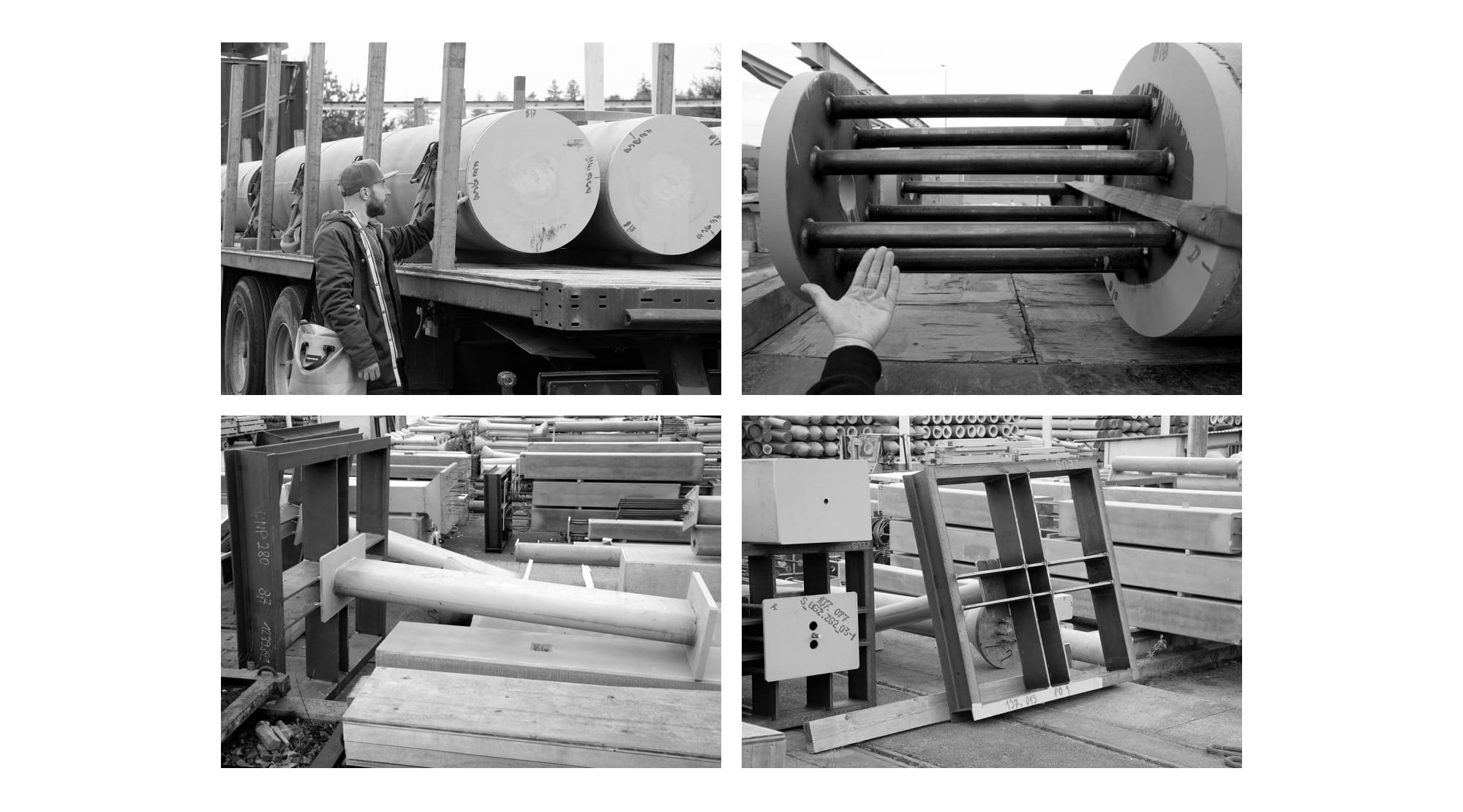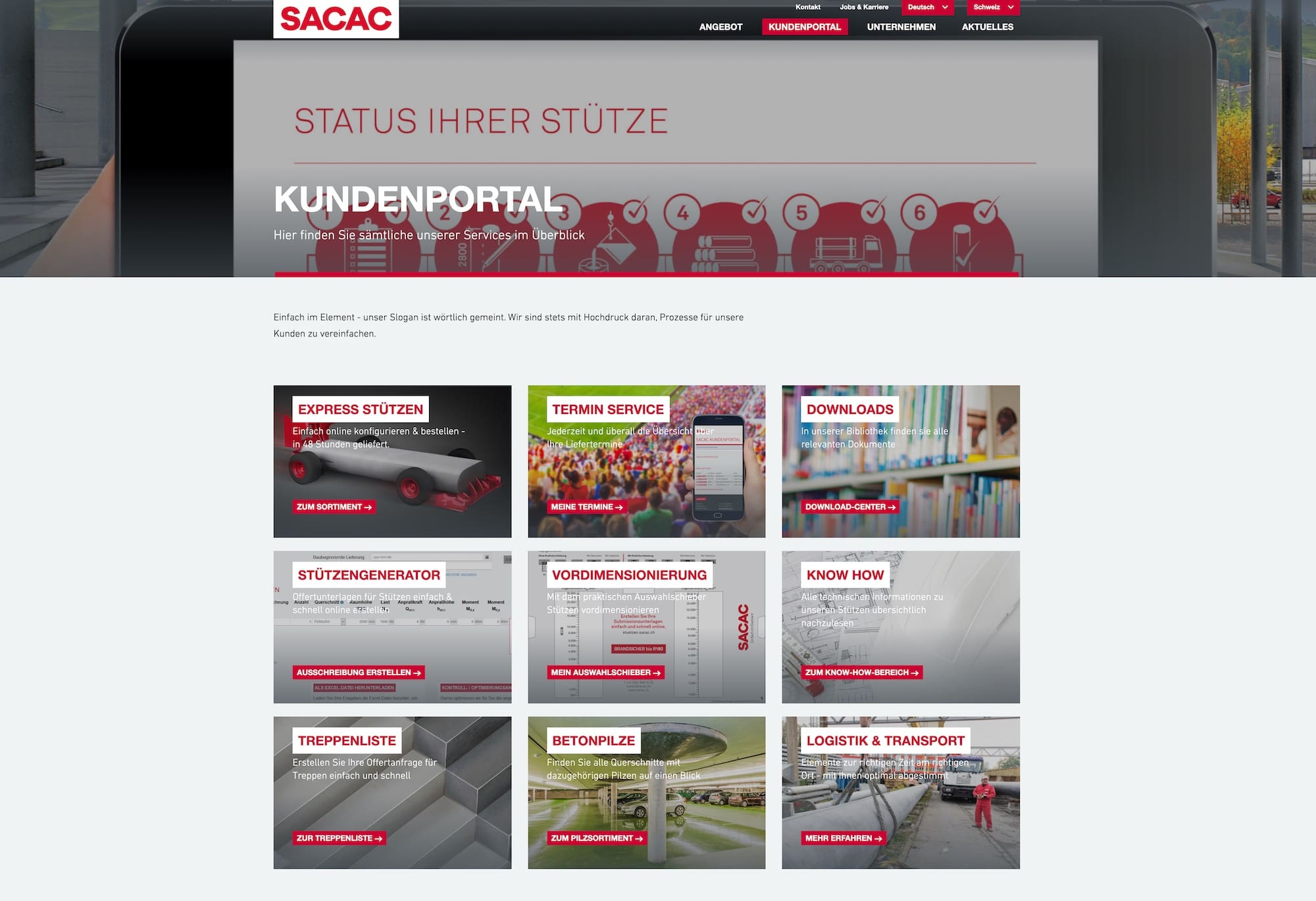
Diese Case Study ist auch auf Deutsch verfügbar
In a multistory building, for example, although the supports mostly have the same external dimensions, depending on the story and location they must be able to withstand different loads and be differently equipped. Unfortunately, before their collaboration with INNOQ, the software solution used by SACAC was a lot less individualized: a mix of ERP system* and Excel typical for SMEs. This was neither effective nor particularly helpful in the preparation of tenders. On the contrary, errors and additional work was the daily fare.
The SACAC case at a glance:
- Conception of a tailor-made software system for tender preparation
- Design and implementation of the system landscape on the basis of self-contained systems and microservices
- Continuous expansion of the system, for example through structural engineering calculations, creation of production planning, delivery date planning, support of purchasing
- Construction of a customer portal including express-order function
- High flexibility and efficiency in the implementation of new features through future-proof planning and trustful cooperation
- INNOQ is not only responsible for digitalization but is also a provider of ideas with regard to strategic considerations, for example the diversification of the product portfolio
- Development of software based on machine learning for the estimation of load-bearing capacities
The original remit for INNOQ was the bundling of queries from construction companies, thus facilitating the preparation of tenders. This was above all important because as a specialist SACAC often receives queries from different construction companies for one and the same construction project, as the companies are participating in the same tender. In the previous system however this could not be recognized. The queries landed in different places and the offers were issued independently of each other – and were therefore all different. On top of this problem came the additional workload of issuing the same offer multiple times.
ERP stands for enterprise resource planning. An ERP system is therefore an IT system that is used to support the resource planning in a company, to plan, regulate, and manage personnel, supplies, or materials, for example. In material requirements planning, as an example, the system should ensure that all the materials required for the manufacturing of the products and components are available at the right time, in the right quantities, and in the right place.
Why was ERP wrong for SACAC?
What for many an advantage is, is for SACAC a decisive disadvantage: ERP systems are always built around one client, one offer, or one contract, and never around a construction project. The system therefore assumes that when a request for an offer is entered, exactly this must be responded to. It doesn’t consider that the same answer may be right for multiple clients. In the construction industry however, exactly this is important. For SACAC this meant that not enough offers could be issued or that the offers were sometimes too expensive or too cheap. In other words, a process that was anything but profitable. Typically, companies adapt their processes to the ERP system or they try to change it. For SACAC however it quickly became clear that the ERP system was more a hindrance than a help in terms of achieving the full automatization of the administrative processes. So SACAC chose a highly unusual path: they wanted to build their own system. With the help of INNOQ, SACAC emancipated itself from the ERP system and made enormous gains in efficiency.
Digitalization with strategy. The main task, namely the intelligent bundling of offers, has been achieved. When SACAC receives a request for an offer, only the key data have to be entered. The offer is then ready to be sent to the client. By opting for a tailor-made software system however, many other challenges could also be resolved.
Our IT solution can now do a lot more:
- fully calculate and issue offers,
- undertake the complete structural engineering calculation (by specifying the supports in the software),
- create the production plans and thus determine the execution of the job,
- automatically incorporate the accounting of client changes (for example when seemingly identical supports need to be differently equipped),
- regulate the delivery date planning,
- and take over large parts of the purchasing (thanks to the integrated date planning, inventories are always known).
In the near future, the production planning will also be integrated. In brief: We at INNOQ come into play when the efficiency can be increased through digitalization. But we don’t only undertake the digitalization – we also offer support at the stage of strategic considerations already.
The ooperation between SACAC and INNOQ with the example of concrete staircases
The existing product portfolio of supports, poles, and masts was to be extended to include concrete staircases. The stair elements were to be offered as prefabricated parts. In the implementation of this plan, INNOQ was part of the team from the very beginning. Not only as software developer but also for the strategic planning of the entire product launch.
The questions were:
- Which conditions must be met in order to produce these stairs?
- Who needs to consult with which engineers?
- Which additional resources will be needed in the production?
- What are the production costs of a staircase?
- What can we do better than our competitors?
One part of the solution was software that calculated the production price of a staircase or support as precisely as possible. SACAC would then know how much profit could be expected from an offer or how much of a discount could be offered. At the same time, SACAC switched its production to a lean production system. The aim was to better align the figures calculated in advance with those actually achieved. Moreover, continuous improvement processes were introduced whereby all employees, regardless of their rank, could give suggestions for improvement in order to increase efficiency.

While SACAC was able to increase its production capacities as a result of this change, INNOQ provided the digital support that ensured that these capacities were actually used. Together we more or less doubled the order volume in the space of six years – with almost identical personnel levels in sales, design, and project management.

A system landscape full of customized solutions
With Ruby on Rails, a system landscape comprising around 15 systems (some self-contained systems, some smaller-cut microservices) was conceptualized and implemented. For every prefabricated concrete part there is customized software for the calculation of the parts, for the confirmation of the structural engineering calculation, etc. Together with customer-specific software for the calculation of production costs, these customized software systems are able to issue offers to clients.
The systems cover the following areas:
- issuing of offers, execution of orders, and connection to the ERP system,
- dimensioning, structural engineering calculation, plan creation as well as price calculation for supports, staircases, and other parts like poles, REBLOC elements, and soon power poles,
- management of delivery dates and draft planning of the production,
- customer portal with the ability to manage deadlines and order supports.
The customer portal offers – alongside the possibility to follow orders – a particularly useful service. Like in an online shop, “express supports” can be ordered via the portal. Eight different profiles are available.

Another highlight is software developed by INNOQ and based on machine learning. For the precise calculation of the maximum load of a concrete support, a complicated and time-consuming specialist program is normally required. For the preparation of tenders however, an accurate estimation is sufficient. This is done by the new tool and so considerably speeds up the process.
Banking on speed
The cooperation with SACAC dates back to 2011. It is always impressive how quickly projects have been jointly implemented. For example, the first functional version of a new SCS (self-contained system) for a new part is typically ready within one working day.
INNOQ supports us as a partner not only in the technical implementation but also in the strategic digitalization of our business model.
Lukas UntereggerHead of Engineering, SACAC
One reason for the fast development speeds – also taking into account the long project duration – is without doubt working with Ruby on Rails. This web framework allows even difficult architecture changes to be implemented quickly. This is how a project remains efficient in the long run. But the most important reason for the long-term performance of the project is the special mutual trust between SACAC and INNOQ. This partnership on equal footing and the resulting autonomous working style ensure that the software is continuously improved and that the development process can be quickly and pragmatically adjusted.
